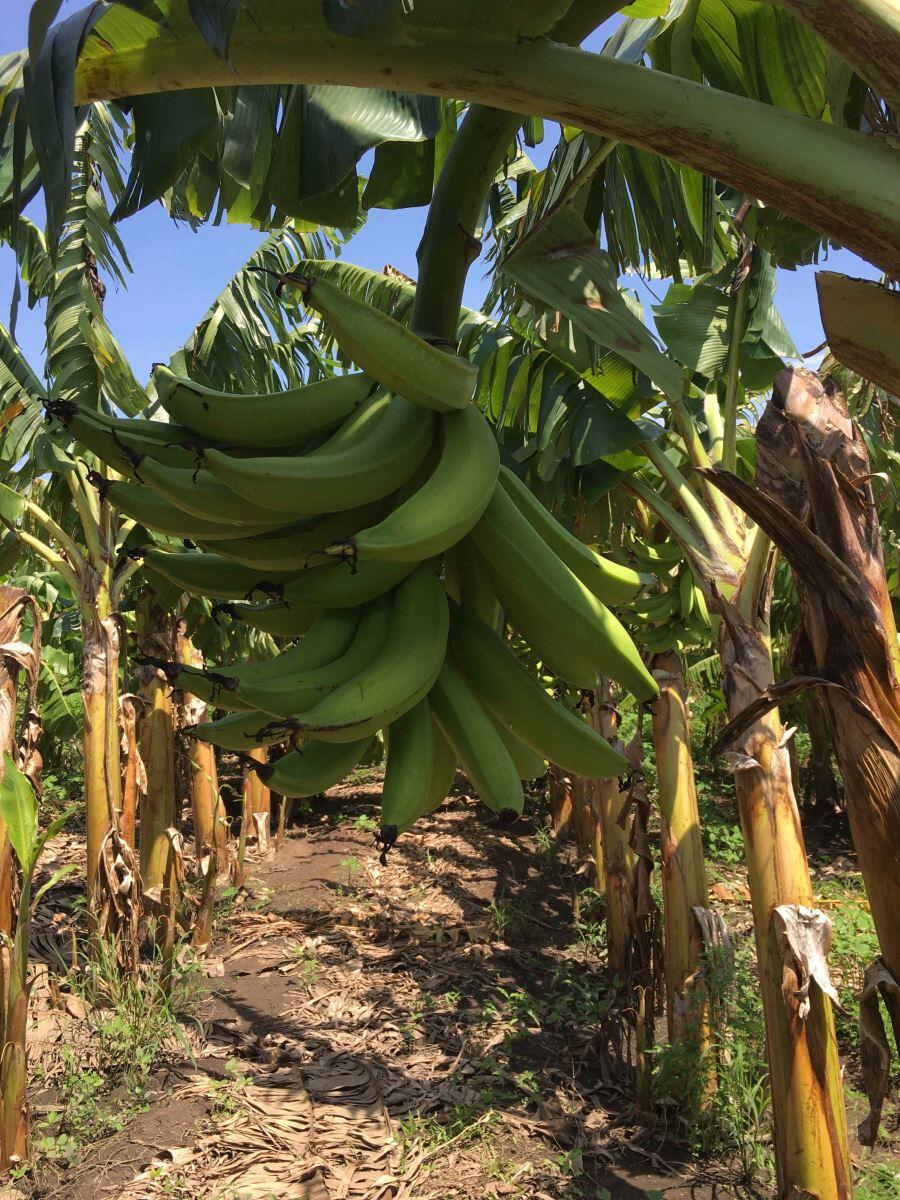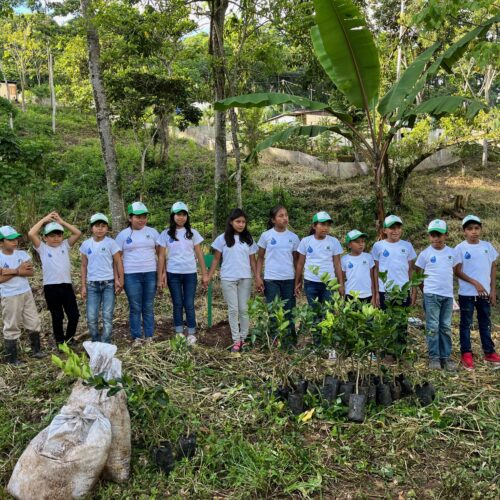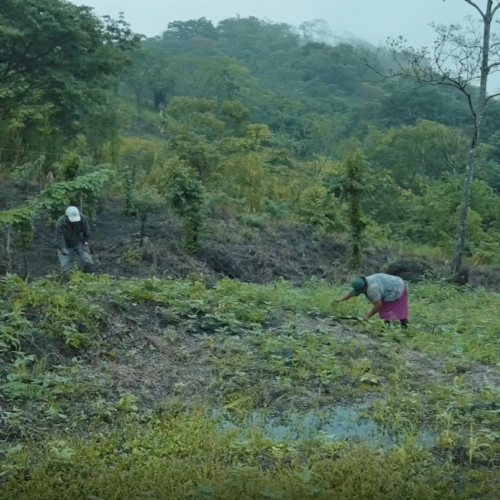

Green parrots in San Marcos, Nicaragua
As an ecology graduate student I drove a Volkswagen bug through the string of tiny countries that make up Central America. I experienced for the first time the mixed landscapes of natural forest and agricultural croplands that make up these small nations.
It was 1968 and I was vaguely aware that the men, the women, the children I saw along the way represented populations of the poorest people in the western hemisphere. But I didn’t understand their struggles to make a living off the land.


Plantain trees in San Marcos
I recognized the superficial signs of poverty. The faces of the people, their raggedy clothing, their piecemeal huts and scattered dooryard activities, roving chickens, skinny dogs—all of these images touched me and left memories never to be forgotten.
Years later, I learned about Agros International, and their program appealed to me as a response to the images I had retained all those years since my travel through Central America. But I didn’t really know what all it would take to raise a family up and out of poverty. How does it work?
Here is what anyone can gather from Agros’s story: they make farmable land available to poor families in Central America by developing small communities. With their on-the-ground staff who assist with both community social formation and agronomy advice, Agros puts people into the business of producing, marketing, and profiting from what they produce. The ultimate goals for each family are land ownership, health and well-being, ongoing education, and prosperity.


Plantain close-up, this time in Luz del Mañana
In June of 2016 I had an opportunity to go down and take a look at two Agros communities in Nicaragua: San Marcos and Luz del Mañana. I was curious and wanted to understand, from first-hand experience, what it really looks like when Agros implements their plan for a community.
This is what I saw.
SAN MARCOS, NICARAGUA – ESTABLISHED 2006, 13 FAMILIES
San Marcos villagers and visitors posing at a house after pouring a concrete floor


San Marcos de Belén is located in western lowlands southwest of Nicaragua’s capitol, Managua. The village has struggled due to poor soil quality and continuous drought to reach the same level of prosperity of other communities, yet after 10 years Agros has decided that the time has come to release them to move forward on their own.
I had the privilege of seeing the happy reunion of members of a Washington church group that has supported and traveled to San Marcos for many years with families from the community. The church group had decided to donate materials for the construction of concrete floors and roofing improvements in families’ homes – an upgrade that will lead to better family health and well-being – as a farewell gift to the community.


San Marcos villagers gathering at the community center
We participated for several days in these work projects. The village men gathered together in force to carry out the new installations, as the visiting church group assisted with arduous mixing of concrete that was poured into the new floors.
Mixing and pouring a concrete floor.

In addition to work, plenty of time was available for simply getting to know each other. We spent time with San Marcos families both in the community center and in several individual homes, where we were invited to sit and listen and learn from the voices of villagers.
What brought them to settle here in the Agros project at San Marcos? What gives them hope? How do they sustain themselves?
In each case, people came from a hopeless and unproductive situation elsewhere to one that offered hope in San Marcos. Belief in family, hard work, and religious faith were expressed over and over as the consistent underpinnings of a positive view of life by the men and women we were privileged to speak to.


San Marcos family
In the face of ongoing droughts and less-than-top results in the annual crop cycles, the men referred to fighting or struggling in order to maintain themselves and their families. Even with the blessings and benefits of what Agros has provided, life remains hard for these people.
PARTNERS TOWARD PROGRESS: ALBA & ARNOLDO
I was particularly impressed with the steady and caring role played by Alba, an Agros staff member who has served the village of San Marcos. She directed our daily visits and contact with the village during our short stay, but more importantly she served earlier to facilitate programs of social organization, health care, and family well being for the San Marcos families.
The mutual respect and connection of Alba to the villagers was impressive to me. This vital role played by Agros staff was something that I had not previously understood at all. Likewise Arnoldo, another Agros staffer, was the man who connected us with and organized the construction crews of village men. As an agricultural technician, he also provided advice and coordinated production of San Marcos’s crops of plantain and papaya.


LUZ DEL MAÑANA, NICARAGUA
ESTABLISHED 2008, 25 FAMILIES
We visited a second, nearby community, Luz del Mañana, situated on the shore of Lake Nicaragua, where irrigation water is available to assist in growing watermelons, as well as plantains and papayas.
This village is at an earlier stage of development, yet clearly headed for success. The Washington church group that supported San Marcos had also previously visited Luz del Mañana, so there were many happy reunions here as well.
The level of prosperity appeared to be on the rise, despite discouragement by ongoing drought conditions that were suppressing production below maximal levels. When asked about why they came and why they are staying, the people of Luz del Mañana showed great hope and contentment with their lives. They expressed their strong appreciation of what Agros has done for them and for the land they are now paying off with their crop income. Soon they will have secured full ownership. Social cohesiveness and community spirits were high.
TOMÁS


My experience at Luz del Mañana was highlighted by lengthy conversation with an older man named Tomás.
Tomás in front of his house at Luz del Mañana
He sought me out for some reason and wanted to walk along with me all the way back to the village from the lake shore, through all the croplands, where he commented on the success of each planting. As we returned to the village, he brought me to his home and into the surrounding patio, beneath a shady almendro tree, to show me the proud base of his family’s existence since moving here from the north several years ago.
He expressed great gratitude and hope, contentment to have a secure base for his own hard work, and for the joy of his family, seated and waiting in front of the house. We concluded our midday visit with a community lunch with his family and all the others who gathered under a ramada at the community center.


Tomás and Jim on the shore of Lake Nicaragua at Luz del Mañana
TAKE HOPE, WORK HARD, AND HOLD FAST
I love the plan of Agros and what I saw of how it is working in the lives of the farming families they serve, proud and hopeful owners of their own land. A fundamental key to individual success was clearly the commitment to work hard, hold fast, and live life for both the present and for the future generation. All that comes together because of the hope and confidence Agros injects into families’ lives – a hope that multiplies with growing prosperity.
A revealing surprise for me was the chance to see the remarkable role played by Agros staff who work in the villages. These caring individuals provide the social encouragement for development of community spirit and cooperation among the men and women of the village, as well as technical advice for the crops and growing conditions that apply to each area of the country.
BY: JIM KENAGY
Jim Kenagy is a retired biology professor and Agros supporter who lives in Seattle, Washington.







